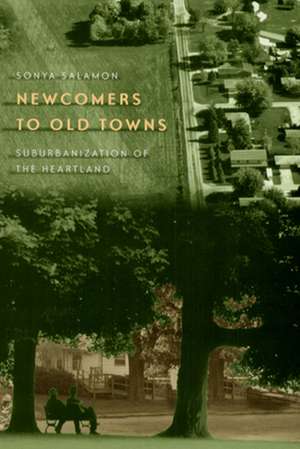Newcomers to Old Towns: Suburbanization of the Heartland
Autor Sonya Salamonen Limba Engleză Paperback – 6 sep 2007
2004 winner of the Robert E. Park Book Award from the Community and Urban Sociology Section (CUSS) of the American Sociological Association
Although the death of the small town has been predicted for decades, during the 1990s the population of rural America actually increased by more than three million people. In this book, Sonya Salamon explores these rural newcomers and the impact they have on the social relationships, public spaces, and community resources of small town America.
Salamon draws on richly detailed ethnographic studies of six small towns in central Illinois, including a town with upscale subdivisions that lured wealthy professionals as well as towns whose agribusinesses drew working-class Mexicano migrants and immigrants. She finds that regardless of the class or ethnicity of the newcomers, if their social status differs relative to that of oldtimers, their effect on a town has been the same: suburbanization that erodes the close-knit small town community, with especially severe consequences for small town youth. To successfully combat the homogenization of the heartland, Salamon argues, newcomers must work with oldtimers so that together they sustain the vital aspects of community life and identity that first drew them to small towns.
An illustration of the recent revitalization of interest in the small town, Salamon's work provides a significant addition to the growing literature on the subject. Social scientists, sociologists, policymakers, and urban planners will appreciate this important contribution to the ongoing discussion of social capital and the transformation in the study and definition of communities.
Although the death of the small town has been predicted for decades, during the 1990s the population of rural America actually increased by more than three million people. In this book, Sonya Salamon explores these rural newcomers and the impact they have on the social relationships, public spaces, and community resources of small town America.
Salamon draws on richly detailed ethnographic studies of six small towns in central Illinois, including a town with upscale subdivisions that lured wealthy professionals as well as towns whose agribusinesses drew working-class Mexicano migrants and immigrants. She finds that regardless of the class or ethnicity of the newcomers, if their social status differs relative to that of oldtimers, their effect on a town has been the same: suburbanization that erodes the close-knit small town community, with especially severe consequences for small town youth. To successfully combat the homogenization of the heartland, Salamon argues, newcomers must work with oldtimers so that together they sustain the vital aspects of community life and identity that first drew them to small towns.
An illustration of the recent revitalization of interest in the small town, Salamon's work provides a significant addition to the growing literature on the subject. Social scientists, sociologists, policymakers, and urban planners will appreciate this important contribution to the ongoing discussion of social capital and the transformation in the study and definition of communities.
Preț: 251.31 lei
Nou
Puncte Express: 377
Preț estimativ în valută:
48.09€ • 49.93$ • 40.10£
48.09€ • 49.93$ • 40.10£
Carte tipărită la comandă
Livrare economică 22 martie-05 aprilie
Preluare comenzi: 021 569.72.76
Specificații
ISBN-13: 9780226734132
ISBN-10: 0226734137
Pagini: 272
Ilustrații: 8 halftones, 7 maps, 24 tables
Dimensiuni: 152 x 229 x 20 mm
Greutate: 0.36 kg
Editura: University of Chicago Press
Colecția University of Chicago Press
ISBN-10: 0226734137
Pagini: 272
Ilustrații: 8 halftones, 7 maps, 24 tables
Dimensiuni: 152 x 229 x 20 mm
Greutate: 0.36 kg
Editura: University of Chicago Press
Colecția University of Chicago Press
Notă biografică
Sonya Salamon is professor emeritus at the University of Illinois and research professor at the University of Texas at Dallas. She is the author of Prairie Patrimony: Family, Farming, and Community in the Midwest.
Cuprins
Preface
Part I Changes in the Heartland
1. Community Connections, Resources, and People
2. Dynamics of Small-Town Change
Part II Newcomers, Old Towns
3. A Persistent Agrarian Town: Smallville
4. Upscale Suburbanization: Prairieview
5. Boosterism Breeds Suburbanization: Bunkerton
6. Blue-Collar Ethnic Accommodation: Corntown
7. Ethnic Succession in Process: Arbordale
8. A Shabby, Dying Town: Splitville
Part III The Postagrarian Countryside
9. Whither the Rural Heartland?
Appendix A The Regional Suburbanization Neighborhood Hypothesis (with Matteo B. Marini)
Appendix B Community Sample Characteristics and Study Methods
References
Index
Part I Changes in the Heartland
1. Community Connections, Resources, and People
2. Dynamics of Small-Town Change
Part II Newcomers, Old Towns
3. A Persistent Agrarian Town: Smallville
4. Upscale Suburbanization: Prairieview
5. Boosterism Breeds Suburbanization: Bunkerton
6. Blue-Collar Ethnic Accommodation: Corntown
7. Ethnic Succession in Process: Arbordale
8. A Shabby, Dying Town: Splitville
Part III The Postagrarian Countryside
9. Whither the Rural Heartland?
Appendix A The Regional Suburbanization Neighborhood Hypothesis (with Matteo B. Marini)
Appendix B Community Sample Characteristics and Study Methods
References
Index
